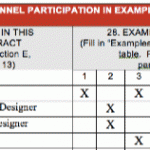
Mike and Bobby are the most popular watermelon salesmen in the city. Each weekend they travel to the country and buy watermelons from the local farmers at 50 cents per melon. They load up their truck with watermelons and head back to the city.
During the weekdays, they sit by city hall with a big sign that reads, “Watermelons: 2 for $1!!!” After a few months of this, the two boys wonder where all the profits went. Bobby says, “I know the solution. We need a bigger truck!”
This may seem like a silly story, but it is one that Certified Public Accountants tell when they describe how many businesses today operate. As Marketers and Business Developers, you may become involved with providing pricing details to clients. Unfortunately, there are many types of services and pricing strategies in this industry. It can sometimes get confusing.
While you may not be the expert on what your firm’s services should cost, you should at least try to make sure that you are not selling your firm’s watermelons for anything less than cost. Before you can do this, you need to understand the different pricing elements, structures and pitfalls.
Elements of Pricing
The following are common elements of pricing that you should be familiar with:
- Rates = What you charge the client for your time
- Overhead = The cost of doing business
- Audited Overhead = The costs of doing business allowable (usually under the FAR Act (Part 31) )
- Fee = A percentage mark-up for profit
- Escalation = A percentage mark-up for cost increases in later years
- Multiplier = Pricing based on a multiple of a rate
- Clarifications/Assumptions = The “knowns” and “unknowns” that you based your pricing on
- Reimbursable Expenses = Expenses the are passed on the client like printing, faxes, etc. Some firms take a 10% on all reimbursable expenses. Depending on your client, travel may be considered a reimbursable expense.
Pricing Formats
The pricing format you provide a client will most likely be based on the type of service and the preferences of your client. Here are some of the pricing formats you might use.
Hourly Rates
A common pricing format within the consulting world is the hourly rate. There are different types of rates that you might want to understand.
Published Rates
Most firms have published rates. These are the rates you charge for each discipline or employee category. For example, you may charge $80/hr for a CAD Operator. That does not take into account how much each CAD Operator makes. It’s just a price that your firm agreed is reasonable for that discipline. Published rates take into account the cost of doing business and are usually developed with an eye towards realizing a profit.
Actual Rates
Actual rates are what people actually get paid. If Sue’s gross pay is $2,000/week then she probably gets paid $50/hr. Therefore, $50/hr is her actual rate.
Blended Rate
Another kind of rate you may see is a blended rate. This is when you provide one rate for a variety of categories. If your Project Manager’s rate is $100/hr and your Designer’s Rate is $80/hr, you may end up using a blended rate of $90/hr. The idea is for the Designer to do most of the work, which will make the job more profitable.
Loaded Rate
Your loaded rate is the (Actual Rate + (Actual Rate * Overhead %) + Fee. State governments often ask for loaded rates. However, when providing loaded rates, it is important to have an understanding of overhead.
Overhead
Here is where things get a little tricky. Often you need to have an outside accounting firm audit your overhead rate based on what the Federal Government allows under its FAR Act. Most clients will pay all or a portion of your audited overhead costs. The calculation for overhead is usually (Direct Labor + Fringe Benefits) ÷ Allowable Costs = Overhead. Sometimes this is calculated as a percentage and sometimes as a multiplier.
Field Overhead
When you are proposing people to work in the field, you will provide a field overhead. When you are in the field, the client is not expected to pay for the worker’s desk back in the office. This number is usually lower than the home office overhead.
Home Office Overhead
Your home office overhead is the allowable costs related to working from your office. A sample overhead might be 160% of the actual salaries. This takes into account costs like rent, electricity, furniture, administrative salaries, etc. Some agencies will cap your overhead. They may decide that they are only paying 113%. That leaves you eating 47% of your audited overhead costs.
Real Overhead
As noted above, your overhead is often based on what the FAR Act will allow. Remember that lunch you took a client to? That is not allowable and ends up being categorized as a disallowable cost. Most marketing costs are disallowable. To get your real overhead you need to recalculate by adding in the disallowable costs. The way I look at it is Actual Rate + (Actual Rate * Real Overhead%) = Break Even Point. If your firm’s Real Overhead is 185% and Sue’s salary is $50/hr, then you should theoretically charge her at $142.50/hr to cover your costs.
Fees
Your fee is what you take on top of everything else to make a profit. For example, your standard fee might be 15%. You may even be taking an administrative fee of 10% off of your subconsultant’s cost estimate, even though they already have their own fee built into that price. Fees may be set by the client or your firm, depending on the situation.
Escalation
Most of us are hoping for a big raise this year. That’s because we work hard and our firms base their businesses on the fiscal year. Construction projects are different. One project could last for several years. So how do you account for raises and increased costs? The answer is escalation. This is a percentage increase you will add every year. This is another area that agencies like to cap. I’ve seen escalation capped as low as 0-2%. If your CEO announced that raises were capped at 0-2% this year, how long do you think it would take before a riot broke out in the office?
Pricing Strategies
Here are some of the ways you might put your price together (i.e. pricing strategies):
Cost Plus
You may be asked for Cost Plus pricing when working for government agencies. This means your cost (actual rate + overhead costs) + something. Here are some examples:
Cost Plus Award Fee/Cost Plus Fee
This is your typical “cost plus” work. Here you are taking a fee (like 10%) on your hours. For each hour you bill, you add 10% onto your cost. This is often known as a “loaded rate.”
Cost Plus Fixed Fee
In a cost plus fixed fee environment, you are getting a fixed fee for the work. This amount doesn’t deviate based on the number of hours you spend on the job. The fee is usually paid out in equal payments over the course of the contract period.
Cost Plus Incentive
This type of cost plus job provides for an incentive based fee to be determined at the end of the job, based on parameters such as target cost and target completion date.
Lump-Sum/Fixed Price
Often in the design field you will be asked for a lump-sum price. You talk to your project managers and write a proposal that says “We will design your building for $500,000.” But don’t send that proposal just yet. There is something that your project managers may not have told you.
When you give a lump sum price, it is important to have a complete understanding of the scope of work you plan to accomplish. And it is even more important to know the scope of work you do not plan on accomplishing. For example, how many meetings do you plan on attending? Will you be performing construction administration/construction observation once the project starts construction? Are you expected to participate in the commissioning of the systems? These are the questions you will answer in your Clarifications/Assumptions.
Clarifications/Assumptions
Most pricing is based on some assumptions. You may typically attend one meeting per month. But each client will expect different things from you. So it is important for you to write down the assumptions your price is based on. This is especially important in the area of Lump Sum/Fixed Price. If you don’t do this, you may be giving the client more than you originally intended. Always try to clarify as much as possible with the client and incorporate that information in your scope of work. Any other assumptions you made need to be addressed in the proposal’s Clarifications/Assumptions section. It is also a good idea to think about what other services you can provide the client. There may be an opportunity to offer some additional services that will add value to your client’s objectives.
Multiplier
You may hear your boss say, “Price this at a 3.0 multiplier.” That often means three times the worker’s actual rate. So if you pay Sue $50/hr, then you have to think of her time as $150/hr. Even if Sue’s published rate is $110, to reach that 3.0 multiplier, you are going to need to use $150 in your calculation.
Not-To-Exceed
Not-To-Exceed means just that. You are not going to charge the client more than the agreed-upon amount. If it costs you twice as much to deliver the agreed-upon scope, that is your problem.
Conclusion/Making a Profit
As stated earlier, your break even point is your Actual Rate + (Actual Rate * Real Overhead %). To get this Real Overhead you will probably need to look at your audited overhead statement and calculate the number yourself. Once you have this number, you can compare what you are charging to your break even. However, keep in mind that the overhead is based on last year’s numbers so that could change from year to year. But it is still a good benchmark. Pricing out professional services can seem like a challenge. But in the end, it’s kind of like determining how much you are selling the watermelons for.





Speak Your Mind